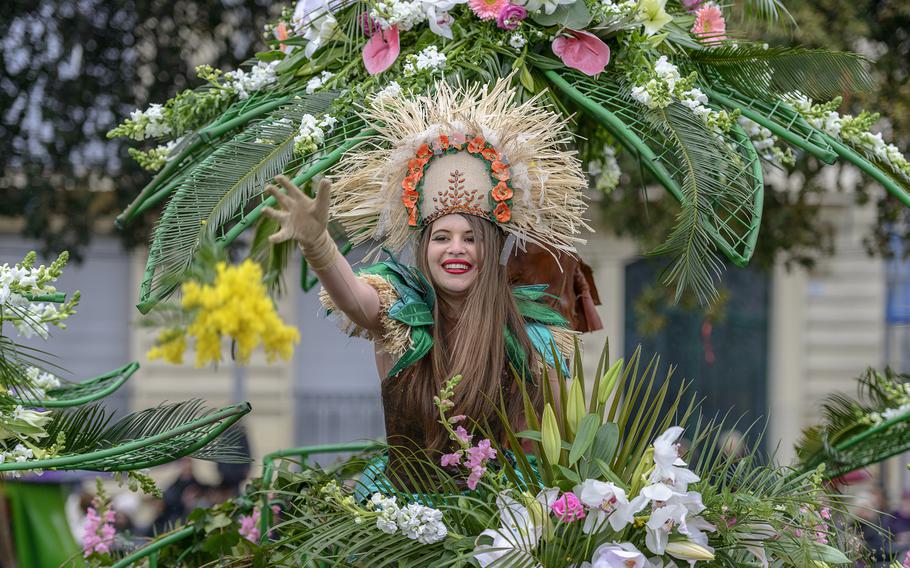
Flower Parades make a lovely introduction to the season in Nice, France. This year’s parades take place Feb. 9, 16, 23 and March 1. (iStock)
Despite the noticeably longer hours of daylight, spring in Europe can still feel a million miles away. One of the welcome signs of the lighter and brighter season that’s soon to come is blossoming beauty, so why not plan a getaway to a place where buds and flowers are about to make their first appearance?
Côte d’Azur, France
With their tiny yellow blossoms resembling pompoms and a heady scent, mimosa trees are a common sight along the roads of Provence. An Australian native, the tree was brought to the area in the late 18th century and found the Mediterranean climate to its liking. The Mimosa Route, a themed stretch of highway stretching nearly 80 miles, is at its best and brightest from January through March. The route begins in Bormes-les-Mimosas and passes through Rayol-Canadel, Sainte-Maxime and Saint-Raphaël before terminating in Mandelieu-La-Napoule, close to the largest mimosa forest in Europe. This town attracts guests from far and wide for its Fête du Mimosa, set to take place Feb. 12-16 in 2025. The festival is made up of carnival-like festivities, with highlights including a night parade of decorated floats that begins at 6:30 p.m. Feb. 15 and the Grand Corso parade and Battle of the Flowers at 2:30 p.m. Feb. 16. Online: tinyurl.com/yc682x8d
Mimosa also figures into the celebrations of the seaside town of Villefranche-sur-Mer, where carnival festivities unfold in its picturesque harbor. The “Combat Naval Feuri,” slated for Feb. 17, will see locals clad in traditional clothing board wooden fishing boats known as “pointus” to engage in a mock battle and toss flowers to the spectators back on shore. Folklore groups add color and music to the scene. Online: tinyurl.com/4zk94st5
The city of Nice, France, always does carnival in a big way, with festivities stretching across four weekends. On dates from Feb. 12 through March 2, tens of thousands of revelers will get caught up in the spirit of this year’s theme, “King of the Oceans.” Among the many program highlights are the so-called Flower Parades, in which costumed actresses ride upon lavishly decorated floats and toss flowers to the crowds. These parades, slated for Feb. 19, 22 and 26, as well as March 1, are ticketed affairs; adult entry ticket prices begin at 7 euros. Online: nicecarnaval.com/en
Mallorca, Spain
The largest of the Balearic Islands is home to more than four million almond trees, which blossom in tender shades of pink and white from late January through late February. Some of island’s largest groves are found in the central and eastern regions, particularly around the towns of Bunyola, Lloseta, Marratxí, Sant Llorenç, Santa Maria, Selva and Sencelles. While Mallorca’s relatively mild climate makes hiking or cycling reasonable options for blossom-spotting, a favorite activity is to board a vintage train that departs from the capital city Palma and makes its way to Sóller. One-way tickets on the hourlong route cost 23 euros, while a return ticket goes for 30 euros. The train runs four times daily between 10:30 a.m. and 6 p.m. Online: trendesoller.com/eng/index
Agrigento, Italy
Agrigento, founded as a Greek colony in the sixth century BC, is home to a vast archaeological area, the Valley of the Temples. Each year in spring, the UNESCO-listed property, along with the city itself, serves as the site for the Sagre del Mandoro in Fiore, or Almond Blossom Festival. From March 8-16, the blooming of the area’s almond trees makes a pretty backdrop to daily performances from folkloric groups from the area and beyond. Each year, the Italian Ministry of Culture nominates a city to be the country’s Capital of Culture, and this year, Agrigento, a city near Sicily’s southern coast, will wear the crown, so visitors can anticipate a full program of culture throughout the year. Online: tinyurl.com/3dh8nfxe
Seville, Spain
Seville in early spring is filled with the sweet scent of orange blossoms, which tend to peak in late February or early March and keep the city awash in their pleasant scent for approximately three weeks. Part of the urban landscape for centuries, the trees are thought to have first been brought over from Asia by sailors and cultivated by the Muslim population for their use in perfumery. Despite their wonderful aroma, the specific type of orange tree ubiquitous throughout the city produces a bitter orange that doesn’t make for good eating on its own; however, they do make a great base for the bitter orange marmalade so beloved in the United Kingdom. Although there’s no particular city festival to celebrate the blossoming period, walks through the Alcazar, Maria Luisa Park or the Cathedral, with its gorgeous Patio de los Naranjos, are treats of scent and sight. Online: tinyurl.com/3ksnxye3
Valeggio sul Mincio, Italy
This town in the Veneto region of Italy close to Lake Garda is home to the the Sigurtà Garden Park, a private garden that’s won numerous gardening awards for the blossoming beauty of its hyacinths, daffodils and tulips, which bask in the spotlight during the annual event known as Tulipomania, running from mid-March to the end of April. This show garden features more than one million tulips in some 300 varieties, flower beds, floating gardens, a panoramic walkway, labyrinth, grotto and more. Events of note within its framework include two Sabato d’Artista, or Days of Artists, slated for March 29 and April 12. Artists will be on hand, working with the tools of their trade, to capture the park’s fleeting beauty. The park is open from 9 a.m.-6 p.m. daily from March 8; adult admission costs 18 euros for adults and 10 euros for children ages five through 14. Online: sigurta.it/welcome